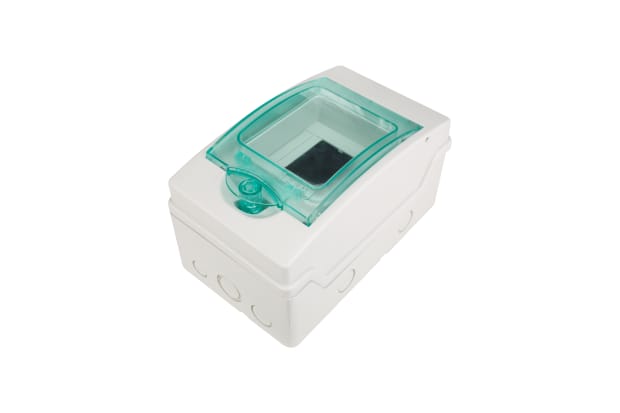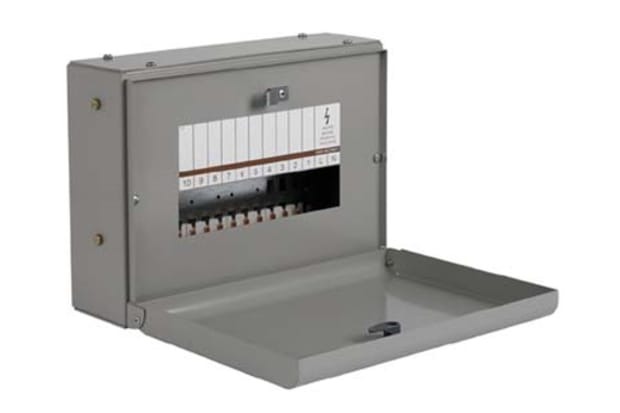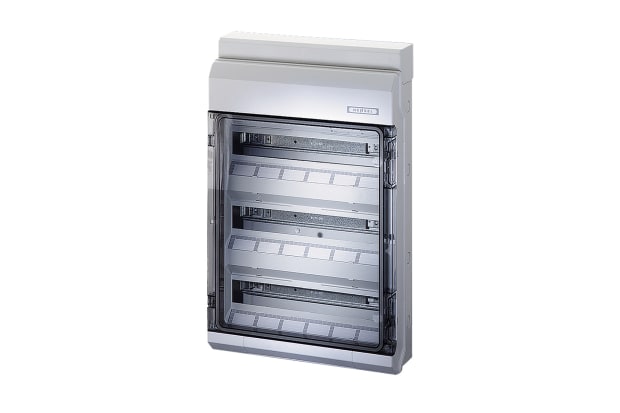- Published 30 Jan 2023
- Last Modified 29 Aug 2023
- 6 min
A Complete Guide to Distribution Boards
Our distribution boards guide explains what they are, their uses and types, and how to connect distribution boards.

This buyer’s guide is designed to give you an overview of distribution boards. We will briefly explain what they are and how they are used, as well as which types of distribution boards are widely available. We will also discuss aspects like electrical ways and outgoing phases to help you choose the best distribution board for your needs.
What is a Distribution Board?
A distribution board or distribution panel (DP) is an important part of an electricity supply system. Its job is to split an incoming electrical power feed into multiple secondary or subsidiary circuits.
Most of the time, each of these secondary circuits will be protected with a fuse or breaker. In the UK, distribution boards like this are often referred to as consumer units in domestic properties.
The terms consumer unit and distribution board are not completely interchangeable. However, for most practical uses, they tend to mean the same thing. Distribution boards might also be called panelboards, breaker panels, or simply electrical panels.
A distribution board or breaker panel separates incoming mains power into various sub-circuits. Usually, all the fuses, breakers and other circuit protection devices for these secondary circuits will be held within the same single enclosure. However, not all distribution boards are necessarily enclosed; some are only semi-enclosed, while others are kept open.
Most workplaces rely on an electricity distribution board to divide and route a single source of outside power to multiple smaller circuits around the building. In many of these settings, the boards will be enclosed for safety. This enclosure is often referred to as a fuse box.
What is the Difference Between a Consumer Unit and a Distribution Board?
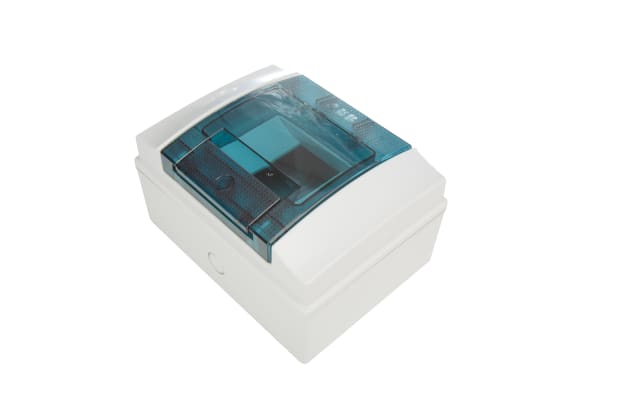
Buyers of electrical panels and related accessory components are often unclear about the difference between a consumer unit and a distribution board. The fact that distribution panels are sometimes referred to as consumer boards can blur the issue further.
In practice, however, the technical difference is only meaningful to certain buyers in specific use cases. Most of the time, people tend to mean the same thing whichever terminology they are using.
The short answer is that a consumer unit is a type of distribution board. In other words, all consumer units are distribution boards, but not all distribution boards are consumer units.
Consumer units are the type of panelboards most often found in buildings in the UK. You will usually recognise them as a metal or plastic enclosure, containing various fuses and breaker switches. These can be used to isolate the incoming mains electricity supply to specific areas of the building.
In this sense, a consumer unit is simply a distribution board that has been approved as a suitable and safe electric panel design for use in typical workplace settings.
What are Distribution Boards Used for?
Whether it is an outdoor distribution board, a commercial distribution board, or a dedicated lighting distribution board for large public venues, all these variants essentially do the same thing. They take an incoming electrical connection, split it several ways, and reroute it to multiple sub-circuits.
This enables more precise and granular control of the supply to different areas, including the ability to isolate and shut down parts of the circuit without completely killing incoming power.
It also provides additional safety features - typically fuses, breakers, and RCDs - that allow for safer use of mains power. As each branch circuit has an individual safety cut-off, the entire electrical system is better protected against overloads, short circuits, and other hazards.
Distribution Board Types
Consumer unit distribution panels come in various common types.
- Main switch consumer units are considered among the safest and most robust protective devices for incoming mains power. All circuits are fully separated, and each is independently protected from earth leakage via RCBOs (residual current breaker with overcurrent protection)
- Dual RCD consumer units are a step down in terms of protective capacity but are still suitable for most standard uses. They consist of two circuit banks, each protected by one of a pair of RCD (residual current device) breakers. These offer robust protection against overheating and electrical fires, or accidentally touching a live wire
- High integrity consumer units are more common in larger buildings where high numbers of sub-circuits are branching off from the incoming mains supply. They combine dual RCD protection with additional RCBOs that can be added in a wide range of flexible configurations
In addition to consumer units, there are various other types of electrical panel boards and sub-distribution boards in widespread use.
Type A distribution boards and Type B distribution boards offer different configurations of busbars, and varying compatibility with certain overcurrent protective devices (OCPD). When selecting a DP for installation in commercial or industrial premises, the correct type to use will depend on compliance with various location-specific codes and standards. You will also need to consider factors such as general operating conditions and environmental factors, as well as any ongoing accessibility requirements.
A sub-distribution board or sub-board is usually a smaller breaker panel acting as a subsidiary to a larger DP. Again, this enables greater control and isolation of a subset of smaller circuits and breakers. A common example might be an RCD Incomer consumer unit, which does not itself have a main switch onboard. This will normally be located on the larger distribution panel that the sub-board is serving.
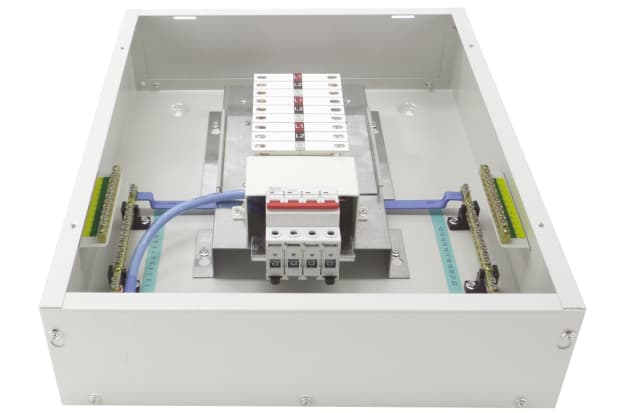
Electrical Phase
Electrical panels designed to split an incoming mains supply into multiple smaller circuits are usually designed as either single-phase or 3-phase distribution boards. Single-phase and three-phase are different methods of connecting outside mains power into a building, and each has its pros and cons in certain situations.
Single-phase power is delivered via two wires coming into the electrical service panel (fuse board). With single-phase power, it is easier to balance the electrical load across the network when there is simultaneous demand from multiple smaller appliances. This is often the case in domestic power circuits.
3-phase distribution boards have either 3 or 4 incoming wires and are typically found in commercial and industrial settings. They are often associated with large, power-hungry machinery in continual use, such as elevators, HVAC systems and factory ovens. 3-phase power is much more efficient and consistent in handling higher sustained load demands than single-phase.
Outgoing Ways and Distribution Board Sizes
The number of outgoing ways specified on an electrical panel gives you a clear indication of how many separate sub-circuits you can run off from it. Or, in other words, how many RCDs and other overcurrent protective devices you can install on a single distribution board.
4-way or 8-way distribution boards are often required for simple circuit dividing and may be suitable for many domestic uses. These small fuse boxes are sometimes referred to as single door distribution boards, as the enclosures they are typically housed in are relatively small.
At the other end of the scale, it is equally common to see much higher way counts on more complex boards and circuits. Double door panels housing 12-way, 16-way and 24-way distribution boards are often required for buildings or installations with higher numbers of branch circuits to feed.
Indeed, DP models are available up to 72-way boards and beyond - although these are usually only needed for full-scale industrial setups and highly technical commercial lighting rigs.
Distribution Board Suppliers
There are many high-quality distribution board manufacturers and consumer unit suppliers available today. Leading brands we work with to supply our extensive range of commercial and industrial electrical panels include ABB, Contactum, Eaton, ETA, Europa, HENSEL, Legrand, Merlin Gerin, Rose, Schneider Electric, Siemens, and Spelsberg.
All the above are known for building robust, reliable DPs and fuse boards to rigorous specifications and exacting safety standards.
